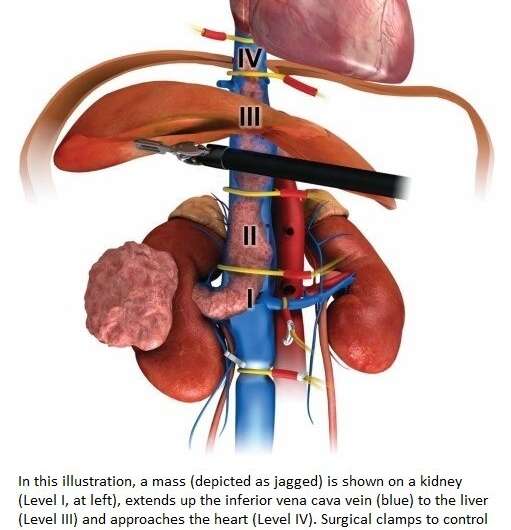Robotic kidney cancer surgery shows desirable outcomes in study

Kidney cancer is not always confined to the kidney. In advanced cases, this cancer invades the body's biggest vein, the inferior vena cava (IVC), which carries blood out of the kidneys back to the heart. Via the IVC, cancer may infiltrate the liver and heart. The Mays Cancer Center at The University of Texas Health Science Center at San Antonio (UT Health San Antonio) is one of the high-volume centers in the U.S. with surgical expertise in treating this serious problem. The Mays Cancer Center is San Antonio's National Cancer Institute-designated Cancer Center.
In a study featured on the cover of the Journal of Urology (Official Journal of the American Urological Association), researchers from the Mays Cancer Center and Department of Urology at UT Health San Antonio show that robotic IVC thrombectomy (removal of cancer from the inferior vena cava) is not inferior to standard open IVC thrombectomy and is a highly safe and effective alternative approach. The affected kidney is removed along with the tumor during surgery, which is performed at UT Health San Antonio's clinical partner, University Hospital.
Harshit Garg, MD, urologic oncology fellow in the Department of Urology, is first author of the study, and Dharam Kaushik, MD, urologic oncology fellowship program director, is the senior author. Kaushik is an associate professor and the Stanley and Sandra Rosenberg Endowed Chair in Urologic Research at UT Health San Antonio.
The open surgery requires an incision that begins 2 inches below the ribcage and extends downward on both sides of the ribcage. "It looks like an inverted V," Kaushik said. Next, organs that surround the IVC, such as the liver, are mobilized, and the IVC is clamped above and below the cancer. In this way, surgeons gain control of the inferior vena cava for cancer resection.
"Open surgery has an excellent success rate, and most cases are performed in this manner," Kaushik said. "But now, with the robotic approach, we can achieve similar results with smaller incisions. Therefore, we need to study the implications of utilizing this newer approach."
The study is a systematic review and meta-analysis of data from 28 studies that enrolled 1,375 patients at different medical centers. Of these patients, 439 had robotic IVC thrombectomy and 936 had open surgery. Kaushik and his team collaborated with Memorial Sloan Kettering Cancer Center, New York; Cedars-Sinai Medical Center, Los Angeles; and the University of Washington, Seattle, to perform this study.
"We pulled the data together to make conclusions because, before this, only small studies from single institutions had been conducted to compare the IVC thrombectomy approaches," Kaushik said.
Findings
The results are encouraging and indicate further study of robotic IVC thrombectomy is warranted. The robotic approach in comparison with open was associated with:
- Fewer blood transfusions: 18% of robotic patients required transfusions compared to 64% of open patients.
- Fewer complications: 5% of robotic patients experienced complications such as bleeding compared to 36.7% of open thrombectomy patients.
These large, technically challenging surgeries last eight to 10 hours and involve a multidisciplinary team of vascular surgeons, cardiac surgeons, transplant surgeons and urologic oncology surgeons, Kaushik said.
"This study is the largest meta-analysis analyzing the outcomes of robotic versus open IVC thrombectomy," Kaushik said. "In more than 1,300 patients, we found that overall complications were lower with the robotic approach and the blood transfusion rate was lower with this approach.
"That tells us there is more room for us to grow and refine this robotic procedure and to offer it to patients who are optimal candidates for it," Kaushik said. "Optimal candidacy for a robotic surgery should be based on a surgeon's robotic expertise, the extent and burden of the tumor, and the patient's comorbid conditions. The open surgical approach remains the gold standard for achieving excellent surgical control."
More information: Harshit Garg et al, A Decade of Robotic-Assisted Radical Nephrectomy with Inferior Vena Cava Thrombectomy: A Systematic Review and Meta-Analysis of Perioperative Outcomes, Journal of Urology (2022). DOI: 10.1097/JU.0000000000002829


















